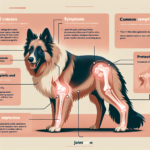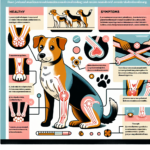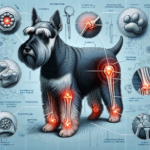Belgian Sheepdog Joint Pain: Causes, Symptoms, Prevention, and Treatment

Introduction
The Belgian Sheepdog, also known as the Groenendael, is a versatile and intelligent breed that originated in Belgium. Known for their agility, loyalty, and protective nature, these dogs have historically been used for herding, police work, and as loyal family companions. With their striking black coats and keen intelligence, Belgian Sheepdogs are both visually impressive and highly trainable.
Like many breeds, Belgian Sheepdogs are prone to certain health issues, with joint pain being a significant concern. Joint health is crucial for this breed due to their active lifestyle and working heritage. Ensuring that their joints remain healthy is essential for maintaining their quality of life and ability to perform various tasks.
Breed-Specific Joint Pain Risks
Genetic Predisposition
Belgian Sheepdogs are genetically predisposed to several joint-related issues, including hip dysplasia, elbow dysplasia, and arthritis. Hip dysplasia is a condition where the hip joint does not fit properly into the hip socket, leading to pain and mobility issues. Elbow dysplasia involves abnormal development of the elbow joint, causing lameness and discomfort. Arthritis, a degenerative joint disease, can also affect Belgian Sheepdogs, particularly as they age.
Age-Related Risks
As Belgian Sheepdogs age, the risk of developing joint pain increases. Typically, signs of joint issues may start to appear in middle age, around 5 to 7 years old. However, some dogs may show symptoms earlier or later, depending on their genetic makeup and lifestyle. Regular veterinary check-ups are essential to monitor joint health as the dog ages.
Activity Level and Joint Stress
Belgian Sheepdogs are known for their high energy levels and need for regular exercise. While their active lifestyle is beneficial for overall health, it can also contribute to joint stress. Activities such as running, jumping, and herding can put significant strain on their joints, potentially leading to wear and tear over time. Owners should be mindful of balancing exercise with rest to prevent overexertion.
Common Symptoms of Joint Pain in Belgian Sheepdogs
General Symptoms
Owners should be vigilant for common symptoms of joint pain, including:
- Limping or favoring one leg
- Stiffness, especially after rest
- Reluctance to move, jump, or climb stairs
- Decreased activity or playfulness
- Swelling around the joints
- Whining or showing signs of discomfort when touched
Breed-Specific Symptoms
In Belgian Sheepdogs, joint pain may manifest more noticeably due to their active nature. Owners might observe a sudden decrease in their dog’s willingness to engage in physical activities they previously enjoyed. Additionally, changes in gait or posture can be more pronounced in this breed.
When to Consult a Vet
If any of the above symptoms are observed, it is crucial to consult a veterinarian promptly. Early diagnosis and intervention can significantly improve the dog’s quality of life and prevent further joint damage. Regular veterinary check-ups are also essential for monitoring joint health and catching any issues early.
Preventive Measures for Joint Health
Exercise Recommendations
Maintaining an appropriate exercise routine is vital for Belgian Sheepdogs. Low-impact activities such as swimming and controlled leash walks can help keep their joints healthy without causing excessive strain. Avoid high-impact activities like jumping or running on hard surfaces, especially for young puppies and older dogs.
Dietary Suggestions
A balanced diet rich in essential nutrients can support joint health. Foods containing glucosamine, chondroitin, and omega-3 fatty acids are particularly beneficial. These nutrients help maintain cartilage health and reduce inflammation. Owners may also consider joint supplements, but it is essential to consult a veterinarian before adding any supplements to the dog’s diet.
Weight Management
Maintaining a healthy weight is crucial for reducing joint stress. Overweight dogs are at a higher risk of developing joint issues due to the additional strain on their joints. Owners should monitor their dog’s weight and adjust their diet and exercise routine as needed to keep them at an optimal weight.
Early Screening and Monitoring
Regular veterinary check-ups and early screening for joint issues can help catch problems before they become severe. For Belgian Sheepdogs, screening for hip and elbow dysplasia is recommended. Early detection allows for timely intervention and management, improving the dog’s long-term joint health.
Treatment Options for Joint Pain
Non-Surgical Treatments
Non-surgical treatments for joint pain include medications, physical therapy, and lifestyle adjustments. Anti-inflammatory medications and pain relievers can help manage symptoms. Physical therapy, including exercises and hydrotherapy, can improve joint mobility and strength. Lifestyle adjustments, such as providing a comfortable bed and avoiding strenuous activities, can also alleviate joint pain.
Surgical Options
In severe cases, surgical intervention may be necessary. Common surgeries for joint issues in Belgian Sheepdogs include hip replacement, arthroscopy, and joint fusion. These procedures can significantly improve the dog’s quality of life, but they come with risks and require a thorough discussion with a veterinarian.
Alternative Therapies
Alternative treatments such as acupuncture, hydrotherapy, and massage can also benefit Belgian Sheepdogs with joint pain. These therapies can help reduce pain, improve mobility, and enhance overall well-being. Owners should consult with a veterinarian to determine the best alternative therapies for their dog.
Lifestyle and Management Tips
Daily Care Routine
A daily care routine for managing joint pain in Belgian Sheepdogs might include:
- Gentle, low-impact exercise such as short walks or swimming
- Providing a comfortable, supportive bed
- Administering prescribed medications and supplements
- Regular physical therapy sessions
- Monitoring weight and adjusting diet as needed
Modifying the Home Environment
Making the home environment more comfortable for a dog with joint pain can significantly improve their quality of life. Consider the following modifications:
- Installing ramps to help the dog navigate stairs
- Providing orthopedic beds for better joint support
- Using non-slip mats to prevent falls
- Ensuring food and water bowls are at a comfortable height
Long-Term Management
Long-term management of joint pain involves regular veterinary check-ups, ongoing physical therapy, and maintaining a healthy lifestyle. Owners should remain vigilant for any changes in their dog’s condition and adjust their care routine as needed. Consistent management can help keep the dog active and happy despite joint pain.
FAQs About Belgian Sheepdogs and Joint Pain
What are the early signs of joint pain in Belgian Sheepdogs?
Early signs of joint pain include limping, stiffness, reluctance to move, and decreased activity levels. Owners should monitor their dogs for these symptoms and consult a veterinarian if they notice any changes.
Can joint pain in Belgian Sheepdogs be prevented?
While it may not be possible to prevent joint pain entirely, taking preventive measures such as maintaining a healthy weight, providing appropriate exercise, and regular veterinary check-ups can significantly reduce the risk.
Are there specific diets that can help with joint health?
Yes, diets rich in glucosamine, chondroitin, and omega-3 fatty acids can support joint health. Owners should consult with a veterinarian to determine the best diet and supplements for their dog.
When should I consider surgery for my dog’s joint pain?
Surgery should be considered when non-surgical treatments are no longer effective, and the dog’s quality of life is significantly impacted. A thorough discussion with a veterinarian is essential to determine the best course of action.
What alternative therapies are available for joint pain?
Alternative therapies such as acupuncture, hydrotherapy, and massage can help manage joint pain. These treatments can reduce pain, improve mobility, and enhance overall well-being. Consult with a veterinarian to determine the best options for your dog.
Conclusion
Joint pain is a significant concern for Belgian Sheepdogs, given their active lifestyle and genetic predisposition to joint issues. By understanding the causes, symptoms, preventive measures, and treatment options, owners can take proactive steps to ensure their dog’s joint health. Regular veterinary check-ups, appropriate exercise, a balanced diet, and weight management are crucial for maintaining joint health. Early intervention and consistent management can help keep Belgian Sheepdogs active and happy, allowing them to enjoy a high quality of life despite joint pain.
Owners should remain vigilant for any signs of joint pain and consult their veterinarian regularly to address any concerns. By taking preventive measures and providing appropriate care, Belgian Sheepdog owners can help their dogs lead healthy, active lives.




